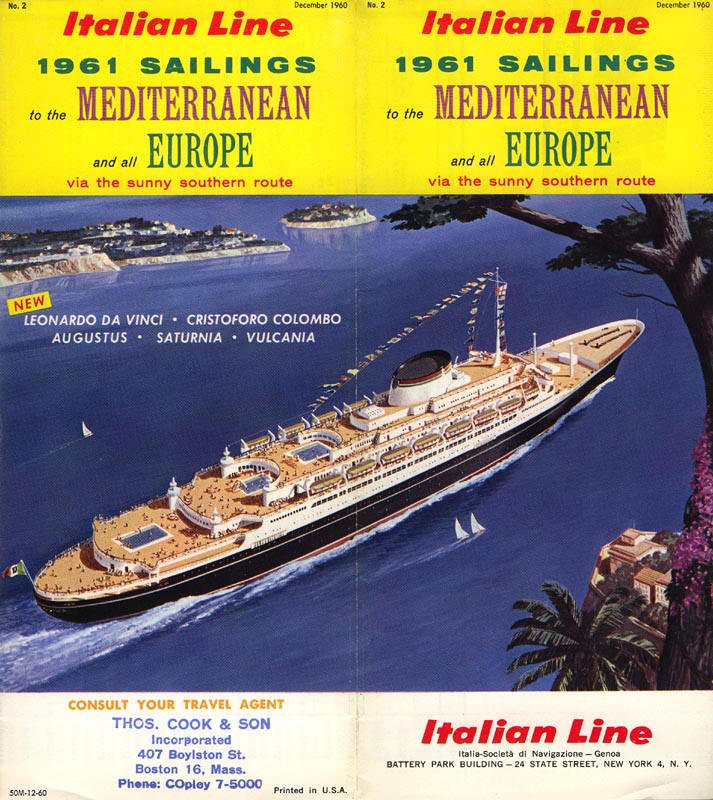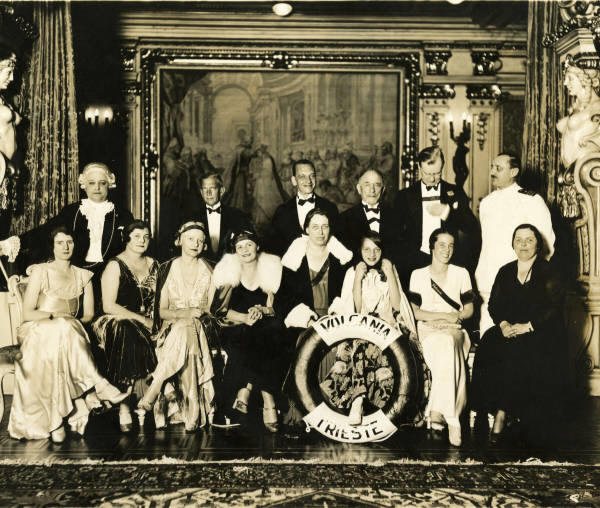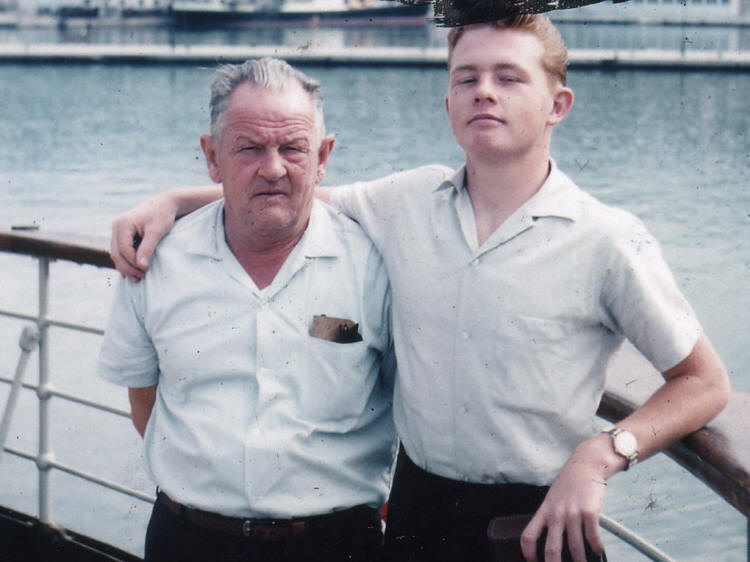Dad Had A Wanderlust Inside Him
In 1961, dad and I took a trip to Europe to visit my Uncle. We went via ship both ways. I cannot remember the voyage to Europe but we returned on the SS Vulcania which sailed from Trieste to New York. 10/28/1955 the MS Vulcania was transferred to run between Trieste, Venice, Patras, Naples, Palermo, Gibraltar, Lisbon, Halifax and New York.
Fireworks - Every evening we would go out onto the deck and watch the fireworks. Not real fireworks but the embers which spilled from the smokestack. Apparently to keep the funnels "clean" they would push some sand into the exhaust fairly frequently and the sand would get hot and rise up the funnel scouring the insides. When the exited the funnel, they were white hot and were quite pretty. Some days however, one should NOT be on the decks behind the funnel as the embers would come to rest on the deck or ones clothes and leave tell-tail marks!
The Head - When we got onto the ship, dad had selected regular passage (standard). When we go to our room there was no head. We asked and were told the heads were down the hall. Dad said not way Jose, so we upgraded to "Cabin Class".
Palermo's Capuchin Catacombs - The city is noted for its rich history, culture, architecture and gastronomy, playing an important role throughout much of its existence; it is over 2,700 years old. Palermo is located in the north west of the island of Sicily, right by the Gulf of Palermo in the Tyrrhenian Sea. We went into the catacombs. The Capuchin Catacombs of Palermo (also Catacombe dei Cappuccini or Catacombs of the Capuchins) are burial catacombs in Palermo, Sicily, southern Italy. Today they provide a somewhat macabre tourist attraction as well as an extraordinary historical record.
The bodies were dehydrated on the racks of ceramic pipes in the catacombs and sometimes later washed with vinegar. Some of the bodies were embalmed and others enclosed in sealed glass cabinets. Monks were preserved with their everyday clothing and sometimes with ropes they had worn as a penance. Originally the catacombs were intended only for the dead friars. However, in the following centuries it became a status symbol to be entombed into the capuchin catacombs. In their wills, local luminaries would ask to be preserved in certain clothes, or even to have their clothes changed at regular intervals. Priests wore their clerical vestments, others were clothed according to the contemporary fashion. Relatives would visit to pray for the deceased and also to maintain the body in presentable condition. The catacombs were maintained through the donations of the relatives of the deceased. Each new body was placed in a temporary niche and later placed into a more permanent place. As long as the contributions continued, the body remained in its proper place but when the relatives did not send money any more, the body was put aside on a shelf until they continued to pay.
About The MS Vulcania

The brochures always looked good!
Built In 1926

The "Vulcania" was built by Cantiere Navale Triestino, Monfalcone, Italy in 1926 for the Italian company, Cosulich Line.
She was a 23,970 gross ton ship, length overall 631.4ft x beam 79.8ft, one funnel, two masts, twin screw and a speed of 19 knots. There was accommodation for 310-1st, 460-2nd, 310-intermediate class and 700-3rd class passengers.
Launched In December 1926
 Launched on 18/12/1926, she sailed from Trieste on her maiden voyage to Patras, Naples and New York on 19/12/1928. In 1930 her accommodation was altered to 1st, 2nd, tourist and 3rd class, and in 1934 to 1st, tourist and 3rd class only.
Launched on 18/12/1926, she sailed from Trieste on her maiden voyage to Patras, Naples and New York on 19/12/1928. In 1930 her accommodation was altered to 1st, 2nd, tourist and 3rd class, and in 1934 to 1st, tourist and 3rd class only.
In 1930 she was fitted with new diesel engines which gave her a speed of 21 knots and was rebuilt to a tonnage of 24,469 tons. In Dec.1936 she commenced her last Trieste - New York voyage for Cosulich Line and in 1937 went to the newly formed Italia Line.
In March 1937 she commenced running from Trieste to New York and in March 1940 commenced her last sailing Trieste - Naples - New York - Trieste. She was requisitioned by the Italian government in 1941 to carry troops to North Africa and in 1942-3 was used on three special missions to repatriate women and children, Genoa - East Africa via S.Africa. In Oct.1943 she became a US Troopship and on 29/3/1946 was chartered to American Export Line to run between New York - Naples - Alexandria. She commenced her last voyage on this service on 4/10/1946 after 6 round voyages and was returned to Italia Line on 15/11/1946.
She then sailed New York - Naples - Genoa where she was reconditioned to carry 240-1st, 270-cabin and 860-tourist class passengers. In July 1947 she made a single voyage from Genoa to S.America and then, on 4/9/1947 resumed the Genoa - Naples - New York service. On 21/9/1955 she commenced her last voyage on this run and on 28/10/1955 was transferred to run between Trieste, Venice, Patras, Naples, Palermo, Gibralter, Lisbon, Halifax and New York.
On 5/4/1965 she commenced her last voyage on this service and was sold to the Siosa Line who renamed her "Caribia". On 18/9/1973 she arrived at Barcelona under tow to be scrapped and departed under tow for Kaohsiung for scrapping on 15/3/1974. [Posted to The ShipsList by Ted Finch - 31 October 1997]
The VULCANIA (1928) Cosulich line, Italia Line. Tonnage 23,970. Dimensions 601' x 79'. Twin screw. 19 knots. Motorship. 2 masts and 1 funnel. Launched Dec. 18, 1926. Maiden voyage Trieste-New York Dec. 19, 1928. 1700 passengers in 4 classes.
We Often Geet Feedback
Dear Paul and Sue,
I read your account of the SS Vulcania with fascination. My family sailed on the Vulcania from New York to Naples to Alexandria in October, 1946 on our way to Saudi Arabia. I was 2 and half years old at the time. I am trying to establish the exact date the Vulcania sailed from New York in October 1946. Do you have any idea how I could go about it? Do you think the owner company retains passenger lists from that far back? I would very much appreciate any suggestions you could make, as it is of some urgency that I find out.
Thank you very much.
Paul Lunde (eMAIL 12/8/2002)

Evenings on deck featured bright embers leaping from the smoke stack!

First Class we were NOT!
MS Vulcania's History
The MS Vulcania was built by Cantiere Navale Triestino, Monfalcone, Italy in 1926 for the Italian company, Cosulich Line. She was a 23,970 gross ton ship, length overall 631.4ft x beam 79.8ft, one funnel, two masts, twin screw and a speed of 19 knots.
There was accommodation for 310-1st, 460-2nd, 310-intermediate class and 700-3rd class passengers. Launched on 18/12/1926, she sailed from Trieste on her maiden voyage to Patras, Naples and New York on 19/12/1928. In 1930 her accommodation was altered to 1st, 2nd, tourist and 3rd class, and in 1934 to 1st, tourist and 3rd class only.
In 1930 she was fitted with new diesel engines which gave her a speed of 21 knots and was rebuilt to a tonnage of 24,469 tons. In Dec.1936 she commenced her last Trieste - New York voyage for Cosulich Line and in 1937 went to the newly formed Italia Line.
In March 1937 she commenced running from Trieste to New York and in March 1940 commenced her last sailing Trieste - Naples - New York - Trieste. She was requisitioned by the Italian government in 1941 to carry troops to North Africa and in 1942-3 was used on three special missions to repatriate women and children, Genoa - East Africa via South Africa. In Oct.1943 she became a US Troopship and on 29/3/1946 was chartered to American Export Lines to run between New York - Naples - Alexandria.
She commenced her last voyage on this service on 4/10/1946 after 6 round voyages and was returned to Italia Line on 15/11/1946. She then sailed New York - Naples - Genoa where she was reconditioned to carry 240-1st, 270-cabin and 860-tourist class passengers. In July 1947 she made a single voyage from Genoa to S.America and then, on 4/9/1947 resumed the Genoa - Naples - New York service.
On 21/9/1955 she commenced her last voyage on this run and on 28/10/1955 was transferred to run between Trieste, Venice, Patras, Naples, Palermo, Gibraltar, Lisbon, Halifax and New York.
On 5/4/1965 she commenced her last voyage on this service and was sold to the Siosa Line who renamed her Caribia.
On 18/9/1973 she arrived at Barcelona under tow to be scrapped and departed under tow for Kaohsiung for scrapping on 15/3/1974
